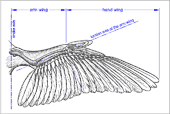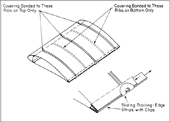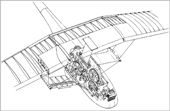Ornithopter
(At "IGNITION" Mechanical Symposium at SVCE Sriperamdur,Chennai)
 |
| An Ornithopter model |
Introduction:
This is a futuristic kinematic mechanism made by Balachandar,Ashwin and myself (SVCE,Mech II yr) with the assistance of college faculty.This is called as "Ornithopter" or "The Flapping Wing Mechanism".The basic idea is to find the advantages of an aircraft having flapping wings.The idea starts from the days of Ramayana where it says Raavana used a "Pushpakavimaana" to fly.(flapping wings).We first made an Autocad 3D design and then went for the model in wood and machined it with lathe(serious work!).
The bird wing, the ideal!
Naturally, the great archetype for technical flapping wings is the living bird wing. His great effectiveness due to his manifold possibilities to move purposeful and to change the shape will certainly be unobtainable in aero modelling for a long time. This is also true for his weight distribution and his sensor technology.
In this drawing by K. Herzog the anatomic subdivision of the bird's wing in arm- and hand section is pictured. It can also to be used advantageously when describing technical flapping wings. The longitudinal parts of these wing sections are rather different depending on bird species.
Shearflex principle
Here an aeroelastic twistable profiled flapping wing according to the Shearflex Principle. This system makes a relatively inelastic covering applicable. If the twisting along the wing is constant and not to excessive, the airfoil contour accuracy is therefore very good.
Here, the twist elasticity will mainly be determinate by the spar designed as wing leading edge.
This system was invented by Professor James D. DeLaurier and Jeremy M. Harris (Canada 1994).
James D. DeLaurier and Jeremy M. Harris (Canada 1994).
This system was invented by Professor
The ornithopter with its tripartition of the flapping wing is interesting, too. Jeremy M. Harris 1977 has applied it for patent.
Application range
Profiled flapping wings or double-sided covered wings may work with a very high efficiency. With their mostly relatively low flapping frequency and the small operating range of lift coefficient of a simple airfoil not much thrust can be produced. Not, at least, if the full lift must be generated concurrently (flying with lift). Therefore, profiled flapping wings are suited especially for a level flight, the gently inclined climbing flight and of course for changing to gliding flight.
External links to other flapping wing designs
- Alphonse Pénaud, (1850 - 1880):
http://www.ctie.monash.edu.au/hargrave/penaud.html - Video about a flapping wing model by Cenek Chalupsky:
http://ovirc.free.fr/Clips_video.php - Construction method of the flying wing model by Jean-Louis Solignac:
http://ovirc1.free.fr/solignac-ornitho.htm - Thrust-Wing model ENTOID by Velko T. Velkov:
http://velkovelkov.blogspot.com/2009/09/entoid.html - The
Double flapping wing airplane
by Karl-Heinz Helling is flying:
http://www.modellbau-thiele.de/schlagfluegel.htm
http://www.mfc-rossendorf.de/fileadmin/Projekte/SchlagfluegelProjekt/SchlagfluegelProjekt.htm - Report about Percival H. Spencer:
http://www.seabee.info/spencer.htm - The
Schwan 1
by Walther Filter in the Aviation Museum Hannover-Laatzen,
point of view atScale Soaring UK
andAir-Britain
:
http://www.scalesoaring.co.uk/VINTAGE/Documentation/Schwan/Schwan.html
http://www.abpic.co.uk/results.php?q=Filter+Schwan&fields=all&sort=latest&limit=10 - Fanning-out wings of the
Birdman
Georges Fraisé:
http://ovirc.free.fr/GFraise.php - Fanning-out wing tips at the Ornithopter Project by Ryszard Szczepañski:
http://www.ornithopter.com.pl - Close-up view of an orange colored Dragonfly:
http://www.grahamowengallery.com/photography/dragonfly_photography.html








No comments:
Post a Comment